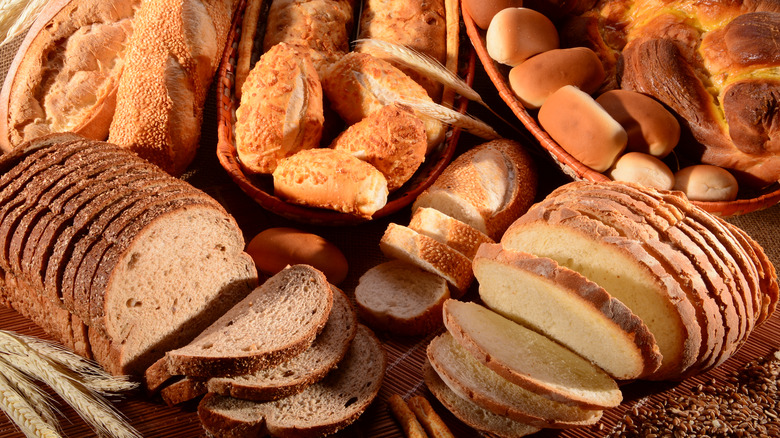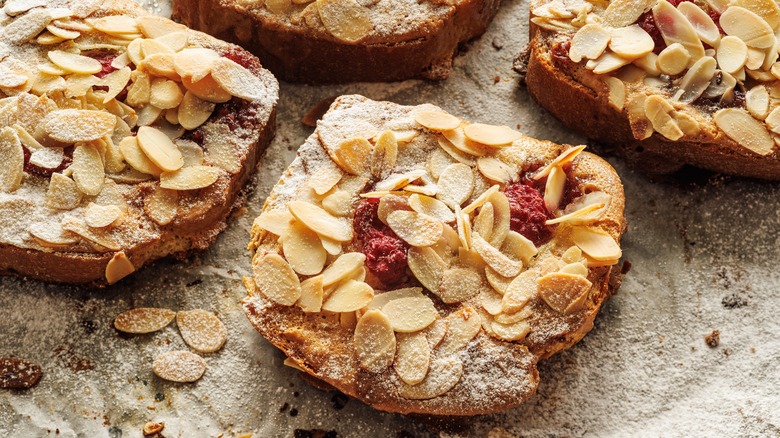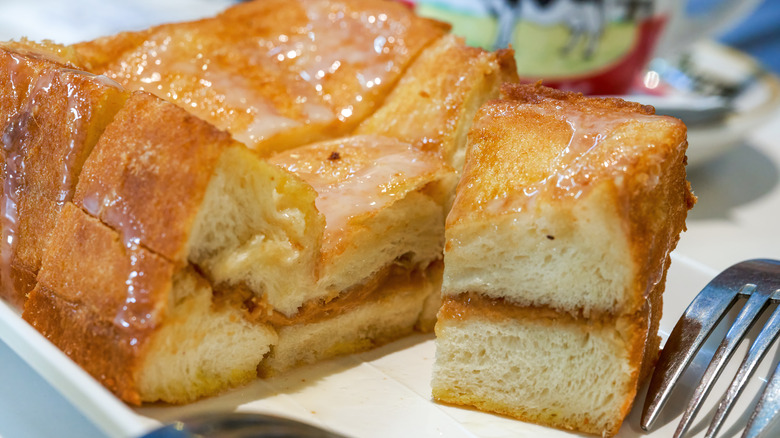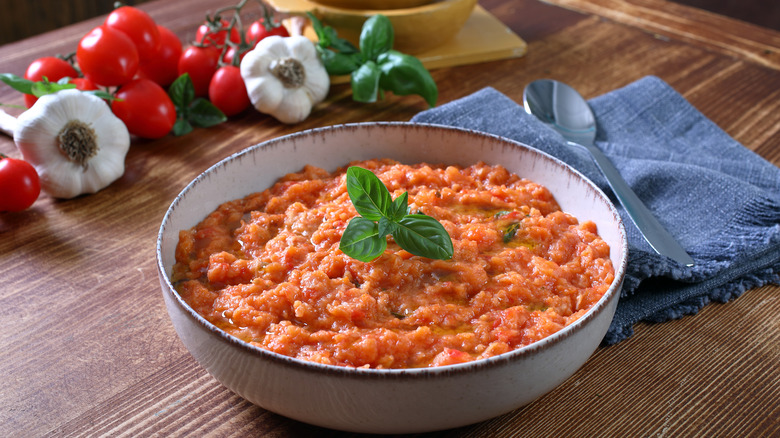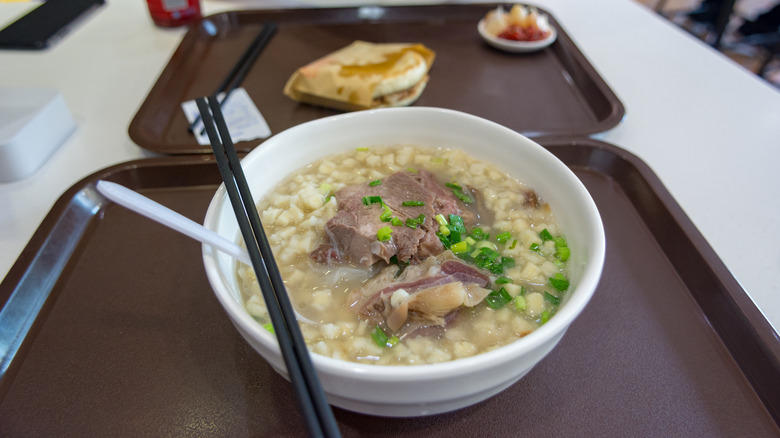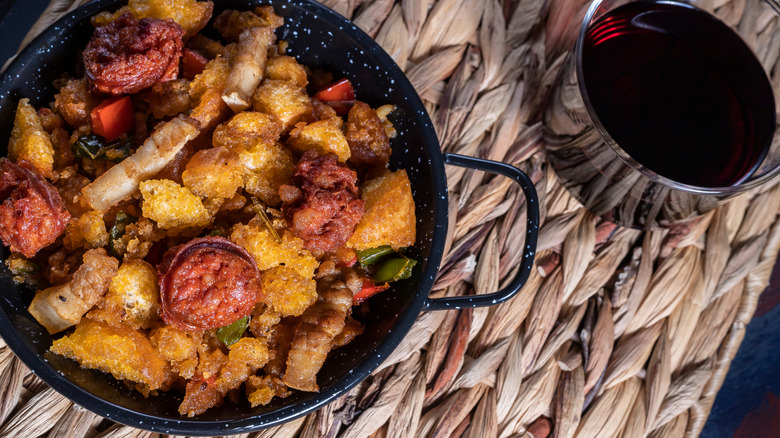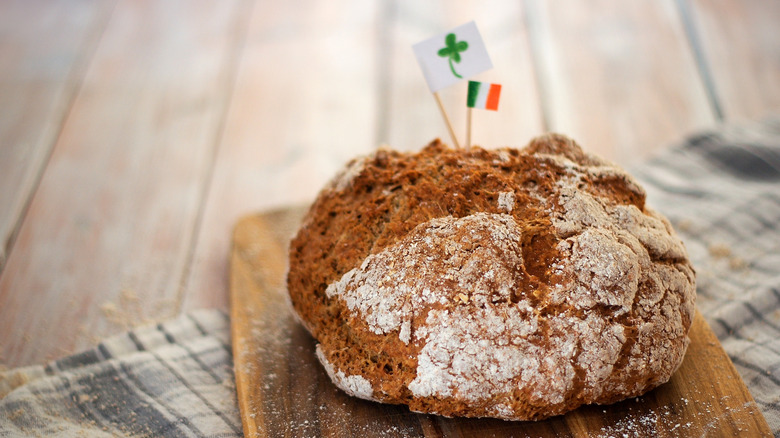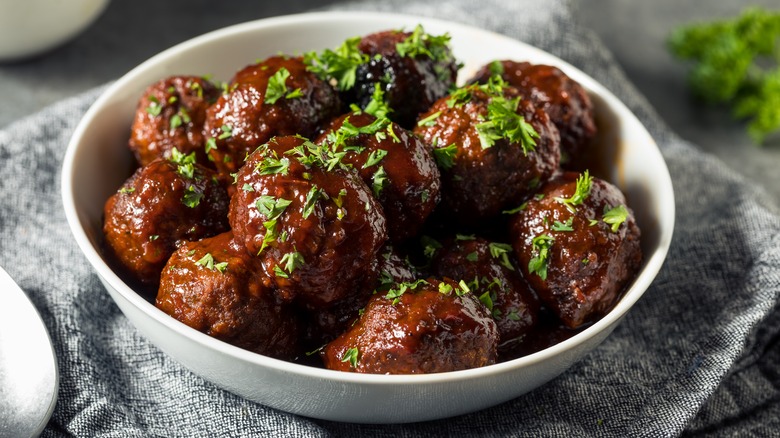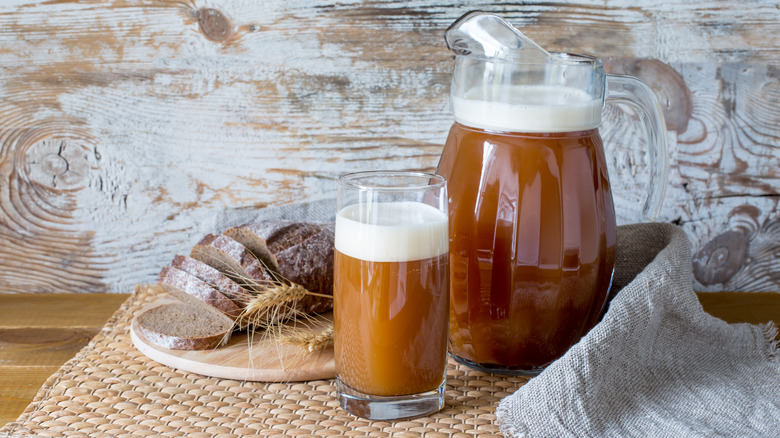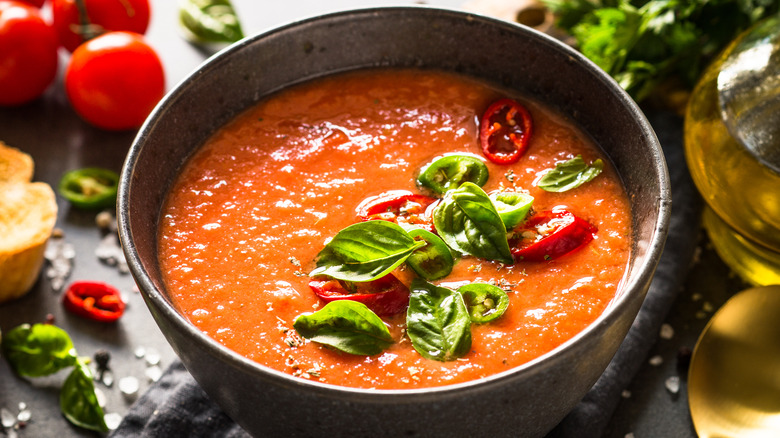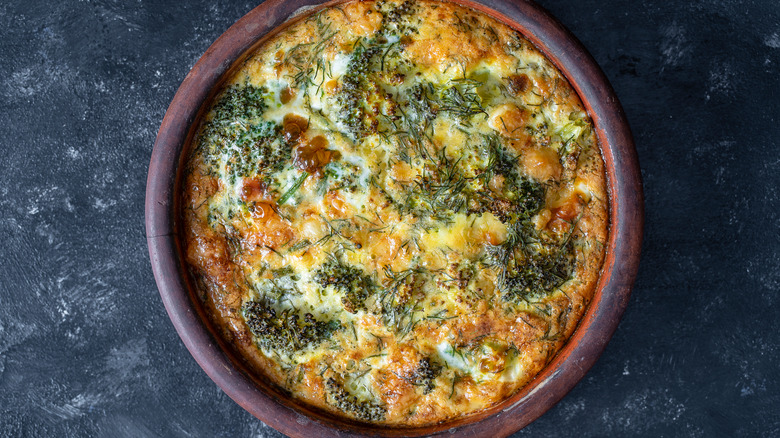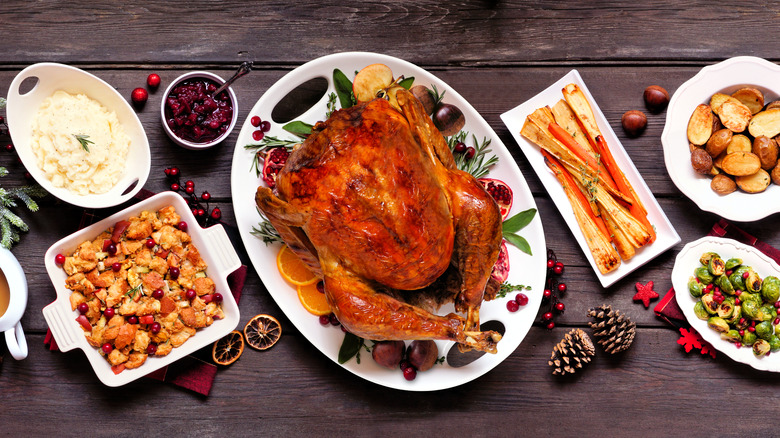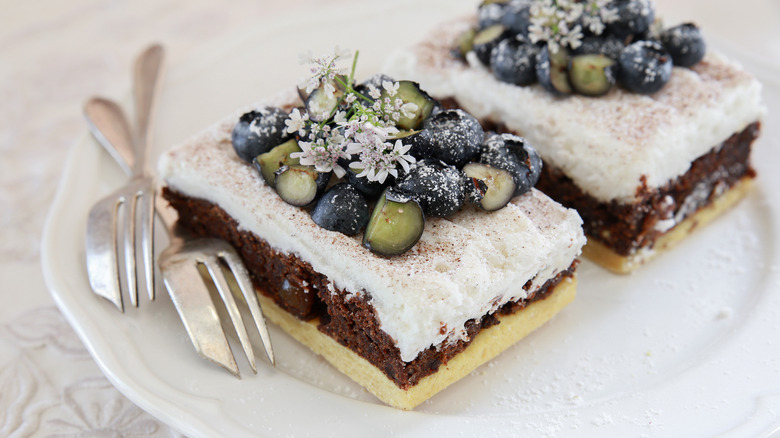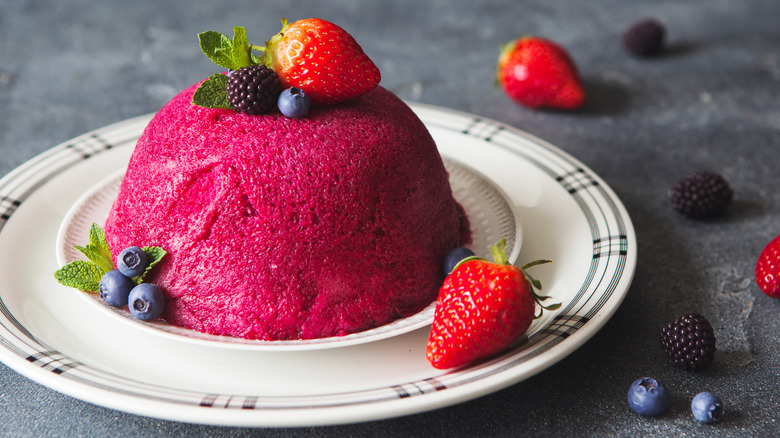13 Unique Ways To Use Day-Old Bread
The bundle of basil you bought three weeks ago for your Caprese salad wilts forlornly at the back of the refrigerator. The bananas on your fruit plate have darkened and softened to the point where they slump under their own weight. And the half-loaf of bread on your kitchen counter has formed suspicious, fuzzy splotches.
It's a tale familiar to many of us around the world — it starts with aspirations of delicious meals and ends with food going in the bin. According to the World Food Programme, we waste one-third of the total food produced every year. That is a lot of food, water, hard work, money, and energy that is needlessly wasted. Additionally, as food waste decays in our landfills, it also contributes to the emission of greenhouse gasses and adds to the rising temperatures around the world (via the UN Environment Programme).
Out of all the food that gets thrown away in the U.S., bread is one of the highest contributors to food waste. According to a 2016 statistic published by Statista, 32% of bread produced ends up being thrown away. While community meal programs across the country and campaigns like Panera's Day-End Dough-Nation donate unsold bread instead of throwing it out at the end of the day, keeping it out of the trash can also take place at home. Apart from your usual bread pudding, croutons, and stuffing, here are 13 unique ways to use stale bread.
1. Use stale sliced bread for bostock
You may be familiar with the almond croissant, or croissant aux amandes. Made from day-old croissants split lengthwise and soaked in syrup before being sandwiched and topped with frangipane (almond cream) and baked, these pastries are a common sight at many bakeries, per The Washington Post.
While you may balk at the thought of making those at home or scoff at the term "leftover croissants," the bostock offers an easier and cheaper alternative for an equally delicious product. In bostock, slices of stale bread are brushed generously with sugar syrup, topped with frangipane made out of ground almonds, butter, sugar, and eggs, sprinkled with sliced almonds, and baked. The result is a pastry with a crisp, nutty exterior, and a soft and chewy interior. According to pastry chef and food writer David Lebovitz, bostock was created by French bakers to avoid wasting unsold brioche, although any close-textured white bread, like pain de mie, challah, or even sliced bread, can be used.
In an interview with Taste, pastry chef Zoë Kanan suggests adding variations to your bostock by adding fresh or dried fruit, or tucking preserves or pieces of chocolate under the frangipane. Alternatively, you can also flavor the frangipane with spices like cinnamon or cardamom for extra oomph.
2. Use day-old bread to make Hong Kong-style French toast
Making a classic French toast recipe is a perfectly respectable way to use up stale bread. After all, the dish's actual name in France is "pain perdu," which translates to "lost bread," referring to the use of old bread that would have been thrown away (via Smithsonian Magazine). However, you may be interested in Hong Kong's version of this beloved breakfast food.
Declared by CNN to be one of the world's best foods, Hong Kong French toast sets itself apart by sandwiching fillings like coconut jam or peanut butter between slices of bread that are dunked in an egg mixture before being deep-fried. The dish is served with butter and sweeteners, such as syrup or condensed milk, at tea houses throughout Hong Kong.
Speaking to the South China Morning Post, store owner Lam Chun-Chung proclaimed that his father, who opened the famous Lan Fong Yuen café, invented Hong Kong-style French toast. In the 1950s, Lam's father noted the popularity of French toast as a luxury food item that was served with expensive, imported syrup at hotels. To replace syrup and lower the costs, he came up with the idea to sandwich the more affordable kaya, or coconut jam, between slices of bread to provide sweetness and fragrance. Of course, the costs of syrup are no longer as high, and now both you and the people of Hong Kong can enjoy French toast with both fillings and syrup.
3. Make stale bread into soup with pappa al pomodoro
Before "sustainable eating" or "zero waste cooking" were buzzwords in the modern food industry, these methods used to be a way of life for many. In what La Cucina Italiana refers to as the "cibo povero," or peasant food of Italy, dishes that used up every bit of food were born out of necessity to feed the family in times of hardship. The Tuscan soup pappa al pomodoro — made simply out of tomatoes, olive oil, and stale bread — is one of these cibo povero dishes.
Here, fresh tomatoes are made into a simple sauce with olive oil, garlic, and herbs; stale bread that has been torn into large chunks is thrown in and left to soak up the liquid. In the Los Angeles Times, Chef Evan Kleiman recommends using country-style sourdough with the crusts left on for the best texture. The resulting dish is a thick and richly flavored, for lack of a better word, mush. For that is what "pappa" in pappa al pomodoro means — a pap or mush meant for babies to eat, per The Guardian.
Despite the name's connotations of baby food, pappa al pomodoro is a dish enjoyed by people of all ages. It's a delicious solution to the loaf of sourdough from the farmer's market slowly going stale in your kitchen.
4. Use up old flatbreads to make yangrou paomo
During the cold winters in Xi'an, China, locals gather in restaurants to break bread. This is meant quite literally, as restaurant patrons deftly break flatbread into small nubs and drop them into their bowls, per The Woks of Life. These bowls are returned to the staff, who then ladle hot mutton soup and rice vermicelli over the bread, creating one of Xi'an's most iconic dishes, yangrou paomo.
Yangrou paomo translates to mutton meat dunk bread; "yangrou" is mutton, "pao" means to dunk or soak, and "mo" is the name of the flatbread (via the South China Morning Post). According to The World of Chinese, the mutton broth is made with aromatics, such as ginger, fennel, and green onion, and poured over the flatbread. In 2016, the local government stipulated that the flatbread must first be torn into pieces that are approximately the size of soybeans. The size of the bread plays an important role, as these soybean-sized pieces are perfect for absorbing the hot soup and forming flavorful morsels that resemble tiny balls of chewy noodles, per The New York Times Style Magazine.
Intrigued? The next time you have several stale pieces of naan or pita bread and a long winter weekend, get out your stock pot and try making this warming and hearty soup.
5. Turn old bread into breakfast with migas
There are two types of migas that are equally delicious and adept at transforming stale food into a sumptuous breakfast. The Tex-Mex version, made by frying old tortillas with scrambled eggs, onions, herbs, and spices, is what many believe to be the perfect breakfast for the morning after a night out. If you have day-old bread on hand instead of tortillas, as well as olive oil, garlic, and chorizo or bacon, Spanish-style migas are the way to go.
According to The Atlantic, migas translates to "crumbs," which is apt in a dish made to use up every last morsel of stale bread in the difficult times following the Spanish Civil War. In Spain, migas is made by moistening small pieces of old bread with water, and frying them in olive oil with lots of garlic, chorizo, and smoked paprika. Cooks Illustrated suggests adding Spanish ham or bacon to add more flavor, and extra ingredients like chopped mushrooms, peppers, sturdy greens, or grapes for a more filling meal. The result is a hearty, flavorful dish made of crispy and chewy bread infused with the flavors of garlic and pork that pairs well with a fried egg.
6. Make brown bread ice cream
If you live outside the U.K., you may not have heard of brown bread ice cream. You may even be wondering about brown bread itself. An Irish quick bread made with buttermilk, baking soda, wholemeal flour, and sometimes oats, it is what The Morning Call refers to as "soda bread's deeper, darker sister."
Brown bread ice cream was popularized by English writer Isabella Beeton in her book "Mrs. Beeton's Everyday Cookery" published in 1907. According to Eater, its closest American cousin is the New England specialty Grape Nuts Ice Cream. While Grape Nuts is a cereal made out of barley and wheat, they both provide a pairing of malty, crunchy nuggets embedded in a scoop of sweet and creamy vanilla ice cream.
Brown bread ice cream is traditionally made using stale Irish brown bread that has been crumbled, tossed in melted butter and sugar, then toasted until crisp and caramelized. These nubbins are then folded into soft, freshly-churned vanilla ice cream before it is left in the freezer to firm up. David Lebovitz notes that stale, whole-grain bread with a dense texture is a fine substitute for brown bread. Alternatively, you can make your own loaf with this brown bread recipe to let your ice cream truly live up to its name.
7. Add panache to your meatballs with panade
Several factors come together to distinguish a great-tasting meatball or meatloaf from a mediocre one. Oftentimes, one of the biggest complaints about these dishes is that they are dry. This is where a panade comes in. A panade is a paste made of bread soaked in milk, and according to Chef John Capon, is added to meatballs and meatloaf to bind the ground meat and add moisture (via RachaelRayShow.com). While many recipes call for breadcrumbs to hold the meatball mixture together, Taste explains that using a large amount of breadcrumbs can cause meatballs to become tough and dry.
By using a panade, the bread is hydrated before being mixed into the meat. This allows the starch to gelatinize and trap moisture in the meat, which protects it from drying out during the cooking process, per Cook's Illustrated.
Incorporating a panade into your meatloaf or meatball recipe not only leads to a richer flavor and juicier, more tender product, but it also allows you to rescue any stale bread that was destined for the garbage. Not convinced? Try this meatloaf recipe made with a panade and see for yourself.
8. Transform stale bread into kvass in an easy fermentation project
A sour, effervescent beverage popular in Slavic countries, kvass has been around since the 10th century. Originating from Russia, the consumption of kvass spread through the region due to the historical Russian military presence in many of these countries, as well as the simplicity of the beverage-making process (via Atlas Obscura).
Traditionally, Russian brown bread made of rye flour was toasted and steeped in water with yeast and optional flavorings, like honey, herbs, or fruits (via NPR). This was left to ferment for several days. When the liquid was fizzy and tangy with a low alcohol content, it was ready to be consumed.
According to author Pascal Bauder in his book "The Wildcrafting Brewer" (via Chelsea Green Publishing), the bread is toasted to provide the kvass with a more attractive color and greater depth of flavor. Additionally, although rye bread is used in the classic recipes, Bauder states that any type of bread can be used to make kvass.
Most commercially-produced kvass is heavily sweetened and contains none of the healthy probiotics that are present in traditional homemade kvass, per NPR. Although there are a few gems in the U.S. making their own kvass, like Honey's in Brooklyn — a meadery that occasionally has kvass on the menu (via New York magazine) – making your own kvass at home to use up stale bread is an easy and interesting project with delicious results.
9. Make a quick summer meal out of old bread with gazpacho
Gazpacho is a classic Spanish soup that was created to use up old bread; aside from the bread, it's also made with tomatoes, peppers, olive oil, garlic, and vinegar. While there are recipes that omit the bread, food writer Felicity Cloake notes in The Guardian that gazpacho made without bread has a poor texture and mouthfeel, where "the soup feels more like a thin salsa."
Gazpacho's popularity during the hot months when tomatoes are in abundance may lead you to believe that the soup was invented with tomatoes in mind all along. However, according to the L.A. Times, the ancestor of gazpacho was a thick soup made out of old bread that was pounded with a mortar and pestle and mixed with garlic, salt, vinegar, and olive oil. It was only in the 16th century, when tomatoes and peppers were brought back to Spain from the New World, that gazpacho earned its reddish hue (via The New York Times).
A lesser-known cousin of gazpacho is ajo blanco, or gazpacho blanco (white gazpacho). It is another chilled soup made with stale bread, this time combined with blanched almonds, garlic, olive oil, and sometimes fruit like grapes or melon..
Whether red or white, both versions of gazpacho are simple no-cook soups involving minimal work and surprisingly impressive results. They can also help reduce your food waste in the hot summer months.
10. Whip up a frittata di pane, or bread frittata
The frittata is, in some ways, the poster boy for reducing food waste. This dish is the perfect vehicle for all the random leftovers in your refrigerator. Grab the last few cherry tomatoes, the slightly wrinkled zucchini, and that lonely slice of ham and mix them with several beaten eggs. Season with salt, pepper, and some cheese, and voila!, you have a lovely, light lunch or snack.
While the frittata originated in Italy, the egg dish is rarely seen on the menu at restaurants. This is because typically it was a way to use up leftovers at home, and was eaten as a snack instead of a meal (via the National Post).
In the same vein as using up leftovers, stale bread can be used as a hearty and inexpensive filling for your next frittata. After the crusts are trimmed off and the bread is cubed, it is soaked in the egg mixture, which moistens it before it joins the other ingredients in a hot frying pan.
A variation by Chef Yotam Ottolenghi calls for soaking the bread in dairy before adding it to the eggs, and baking the frittata instead of frying it. This produces a frittata that Chef Ottolenghi states is "light, fluffy, and comforting in a way that you can only get when you soak bread with milk and cream" (via the Daily Mail).
11. Continue a British tradition with bread sauce
Pale, lumpy, and the consistency of oatmeal, bread sauce may not be the most appealing-looking sauce in the culinary world. Made by soaking stale bread in hot milk infused with onion, bay leaves, cloves, and nutmeg, it is a British tradition served alongside the Christmas turkey or ham, according to Nigella.
However, outside the U.K., many people have never heard of bread sauce, let alone tried it. British cookbook author Nigella Lawson even admits that the concept of bread sauce may seem "disgusting" to those unfamiliar with it.
Bread sauce, like many of the other foods on this list, was born out of attempts to cut costs and reduce waste. NPR states that the sauce has its origins in medieval England when people used bread to make sauce due to its availability and lower costs compared to eggs and butter.
Despite its unassuming appearance, there is a reason bread sauce has remained a tradition for so long. According to Vice, its charm lies in its modest nature. The simple bread sauce is comforting in its reliability and tradition and allows the flavor-packed food of Christmas dinner to shine. At your next dinner party, serve some bread sauce and introduce your guests to a recipe that has been around for centuries.
12. Save your old bread to make gur cake
Gur cake, Chester cake, donkey gudge, donkey's wedding cake -– there are few pastries with names as varied and colorful as this one. According to Independent.ie, Gur cake, as it is known in Dublin, varies in name according to the region in Ireland in which it's made.
In her book "Irish Traditional Cooking," Darina Allen quotes food historian Regina Sexton, who states that gur cake was popular amongst children, especially those from poorer families for whom the pastry was more accessible. This led to the "tough street urchins" that roamed Dublin's streets being dubbed "gurriers" in reference to their penchant for the cake.
A fruity, spiced slice much like a cross between a fruit cake and a mince pie, gur cake, as noted by Alan Davidson in "The Oxford Companion to Food," was made by bakers to repurpose scraps of old bread and cake. To make this pastry, stale bread and cake are mixed with water or tea, dried fruit, and spices to become a paste, which is spread thickly between two sheets of pastry and baked. After cooling, the sheet of gur cake is dusted with icing sugar and cut into squares.
Save your old bread and stale cake and make a batch of gur cake, if only to see your friends and family's reactions to being offered a slice of donkey gudge.
13. End your meal with a summer pudding
Another traditional British dish using leftover bread is summer pudding, an iconic treat in all its vibrant, purple glory. A seasonal dish, it is commonly made with berries available during the summer, such as blackcurrants, raspberries, and redcurrants, that are encased in a lining made of sliced white bread, according to Nigel Slater at The Guardian. As a dessert made with no added fat, King Arthur Baking Company explains that summer pudding was created in the 19th century for the health-conscious who still wanted some form of luxury in their diets.
To make summer pudding, the berries are simmered with sugar and water until they release their juices. They are then layered between thick slices of white bread in a casserole dish, and a final slice of bread is placed on top as a lid. A small plate with a heavy weight perched upon it is used to press and compact the pudding while it rests in the fridge overnight before being unmolded.
In the bread used to line a summer pudding, the crusts are usually trimmed off. British chef Tom Hunt takes this recipe's potential to reduce food waste further; he suggests cutting the crusts into cubes and adding them to the berries to create more filling for a lower cost.
Summer pudding is the perfect treat on a hot day. Without turning on the oven, you can serve a striking dessert that is friendly to your wallet and the environment.
